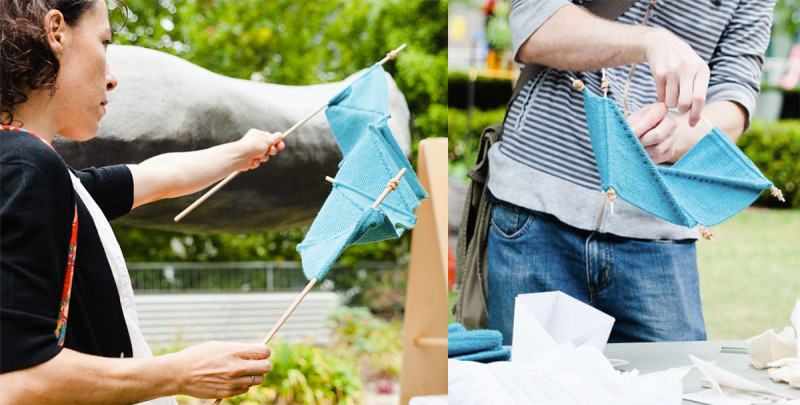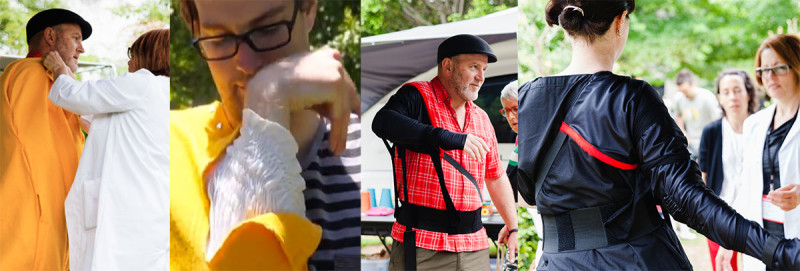Overview
The PKI project tries to understand how to give people the feeling of being in someone else’s body, someone with different physical abilities and constraints. […]
Green Knits, Blue Cushions and Sleeves emerged from a crafted research inquiry. These probes invite the public into considered engagement of the ethical, social, personal, political and cultural implications of the PKI project. To date, they have been tested at a Lab in the Wild participatory exhibit at The National Gallery of Victoria, International, in Melbourne Australia […]. This page provides an overview of the PKI Phase I probes.
Following are detailed descriptions of each of the probes, for more info, see the associated publications, listed in the colophon:Green Knits – frameworks for emergent embodied enquiry

Green Knits – frameworks for emergent embodied enquiry
The intention of the Green Knits is to enable participants to ‘feel’ a particular movement by prompting them to make that movement. The knits leverage the inherent ‘soft’ logic of different knitted stitch architectures, such as the shift between the balance of an all-needle rib structure to a single jersey, which results in a natural fold: a form with an internal memory.
Complex forms of fabric origami were developed to form the Green Knits, taking inspiration from tensegrity structures: structures that maintain a stable integrity through a set of discontinuous compressive elements, and a set of continuous tensile elements. The results act as a guide to lead participants through a relatively simple movement such as of two hands coming together and moving apart in a spiraling form.
The Blue Cushion Prototypes

Blue Cushions – invisible, internal prompts: Scapulo-humoral Rhythm • Hip & Butt • Excessive Kyphosis • Varus (Trendelenberg), position I & II
The Blue Cushion prototypes work with the body’s capacity to enable or disable its own affordances, by acting on mechanical, cognitive and sensory elements of the body. Each cushion serves as a pressure point to shift posture or stimulate nerve paths and send messages to the brain. Significantly, they don’t noticeably change the way a person moves from an outside perspective. Rather, they shift perception of movement, bringing reflection to internal changes – as with the Feldenkrais Method, they change how making a movement feels. There are currently four cushions-sets that function as follows:
- Scapulo-Humeral Rhythm: places pressure around the scapula (the shoulder blade), to impact the way it feels to lift the arm.
- Hip & Butt: hip places pressure over the lateral border of the Lattisimus Dorsi (the muscle that joins the lower thoracic, lumbar and sacral vertebrae to the humerus, (the upper arm)). It also places superficial pressure over the femoral cutaneous nerves, from the 3rd lumbar vertebra, through the quadratus lumborum muscle, towards the iliac crest (the hip); butt places pressure over the sciatic nerve. They are used together, to impact the way it feels to walk or sit.
- Excessive Kyphosis: applies gentle pressure over the first to third cervical vertebrae, along the neck towards C7, to give the wearer the feeling they have excessive kyphosis, or “a studious hump”.
- Varus (Trendelenberg): Varus mechanically interferes with the body as a person walks. It may be worn in two ways: (1). Fig 2(iv) behind the thigh, with the bulbous section over popliteus (the back of the knee); or (2). Fig 2(v) over the adductors (between the thighs). In (1), the cushion places pressure on the varus, and interferes with knee bend while walking. In (2) it mechanically tilts the pelvis and separates the thighs, to alter the gait in a different way. Despite operating mostly mechanically, the impact of this cushion on the experience of walking is felt internally rather than perceived externally.
Sleeves – hidden and visible movement mazes

Yellow Sleeve, Red & Black Sleeve
The Sleeves mechanically impact freedom of movement, coherent with a range of physical pathologies. They were particularly inspired by choreographer, Benjamin Hancock’s, explorations using hypermobility to segment the body.
- Yellow Sleeve: is a soft felt maze that constricts forward flexion and extension of the arm. It acts as both a guide and constraint for upward reach, constricting the gesture into deformed positions as the person reaches upwards. The maze itself is internal to (hidden within) the material structure of the garment. Participants are able to move through it at their own pace, exploring the movement possibilities it affords. Importantly, Yellow Sleeve is made of very soft felt, comforting to the touch, not unlike a baby blanket. Yet the movement this garment affords is not typically thought of as soft, gentle or desirable. The inherent conflict destabilises values attributed to movements that may be considered disabled or outside the norm.
- Black & Red Sleeve: constrains and reframes abduction, adduction, flexion and extension (different kinds of reach), by transforming the movement affordances of the arm into a shifting maze. The segmenting, created by the stocking straps, create different constraints and possibilities depending
Significantly, we have discovered that it is the least resolved prototypes – the Knit Structures – that serve as the most accessible entry point for a broader research dialogue. The openness seems to draw people in who might not otherwise engage, gives permission to make suggestions and triggers the imaginings of possibilities. The unresolved prototypes have also become an important point of entry for the more highly resolved, and seemingly challenging works, such as the Sleeves, which must be worn. In doing so, they enable a greater range of participation with all three design frameworks.